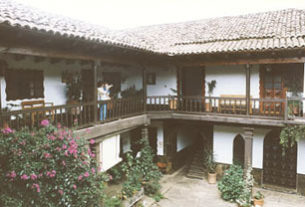Mexican Kitchen
While passing the rows of restaurants surrounding downtown Puebla’s Parian crafts market, one cannot help but notice that every one of the many display bowls of mole poblano is adorned with a liberal sprinkling of sesame seeds. Walking past these displays not long ago, I began thinking about the part sesame seeds play in Mexican cooking, especially here on Central Mexico’s altiplano, where several different moles, pipians and sweets have traditionally been prepared with them.
Although sesame seeds were discussed briefly in “Semillas en la Cocina: Cooking with Seeds,” some research reveals their importance in both the cuisine and agriculture of Mexico. Brought by the Spaniards, who had been introduced to them by the Moors, sesame seeds quickly became part of the national repertoire of ingredients and an important crop as well.
Mexico’s national dish, mole poblano, in addition to being garnished with whole sesame seeds, is flavored with ground ones as part of the seed and spice mixture that is the basis for mole paste. They are also an important flavoring element in pipian rojo, the region’s red pipian, usually served with poultry or pork. In the Sierra Madre Oriental, which runs through the northern part of the state of Puebla and the northwestern edge of Veracruz, a delicious version of pipian rojo is served with fish. Also in Veracruz, tlatonile de pollo – a sesame seed, pumpkin seed and chile sauce – is served with chicken, which is sprinkled with additional sesame seeds.
The seeds are used in sweets as well, including the pumpkin and sesame seed candy called pepitoria, which resembles a nut brittle. And in many of Puebla’s regional restaurants, especially those specializing in Colonial-era recipes, a cellophane-wrapped sesame seed candy is offered to customers after dinner instead of a mint. Much of Mexico’s pan dulce, or sweet bread, is decorated with sesame seeds, especially pan de muertos, the Day of the Dead bread.
In Mexico, sesame seeds are called by their Spanish name, ajonjolí, derived from the Arabic jaljala, meaning “sound, echo” referring to the rattling of the ripe seeds within the seed capsule, which is actually the plant’s fruit. Because the seeds literally burst out of their capsule when they reach maturity, the phrase “open sesame” was an apt magic password for Ali Baba in the Arabian Nights tales.
Sesamum indicum is one of the world’s oldest cultivated crops, used for oil, flour, and as a nutritional addition to other foods. Originating in Africa and India, sesame seeds were widely used in ancient Egypt and Babylon for culinary, cosmetic and medicinal purposes. A 4,000-year-old Egyptian tomb painting depicts sesame seeds being added to dough. Today sesame seeds are used for oil, candy, cake, flour and the sesame paste called tahini, which is sold as ajonjolí molido in the markets of Central Mexico.
Typically a crop raised by small farmers and usually harvested by hand, sesame grows well in both tropical and temperate climates and withstands high temperatures and minimal rainfall. In Mexico, which is one of the biggest sesame seed producers in the world (after India, China and Burma) and the biggest in Latin America, Sinaloa and Guerrero are the most important sesame producing areas. The following quote from the Nut Factory Kitchen is a vivid description of a Mexican sesame field: “If you walk through a sesame field in late summer in Mexico after dark, you will hear the loud and scattered popping sound of sesame plants exploding and spitting their seeds.”
Most of Mexico’s sesame seed export goes to the United States, where fully one third of all the sesame seed imported into the country goes to McDonald’s for its sesame seed buns. The white sesame seeds grown in Mexico are generally preferred in the Western counties, whereas the black variety is favored in Asia.
Whether white or black, sesame seeds are an excellent source of magnesium, copper, calcium and vitamins B1 and E. They also have antioxidant and anti-carcinogenic properties, as well as raising the blood level of HDL (“good”) cholesterol. The oil pressed from the seeds has been used in natural healing for thousands of years because of its antibacterial and anti-inflammatory properties.
When buying sesame seeds, look for natural, or unhulled, seeds, since the hull helps prevent the seeds from becoming rancid. Like nuts, which also have a high oil content, they should be stored in the refrigerator. They will last in the refrigerator for up to six months and in the freezer for up to a year.
Sesame seeds can be toasted to bring out their nutty, slightly sweet flavor. Just place them in an ungreased pan over medium-high heat and toast them for 1-2 minutes, turning them a few times to prevent scorching. Toasted sesame seeds are a good garnish for green salads. Add them while melting butter to pour over green vegetables such as asparagus. In Latin America they are sometimes sprinkled over the caramelized sugar that tops a dessert dish of fried plantains.
The following recipes reflect the use of sesame seeds in both savory and sweet Mexican dishes.
- Pescado en Pipian Rojo: Fish in Red Pipian
- Tlatonile de Pollo: Chicken in Sesame Seed, Pumpkin Seed and Chile Sauce
- Trucha Empapelada con Ajonjolí: Trout with Sesame Seeds En Papillote
- Mole Poblano de Guajolote: Puebla Style Turkey Mole
- Pipian de Semillas de Chile: Chile Seed Pipian
- Pato en Pipian Rojo: Duck in Red Pipian Sauce
- Pepitoria: Pumpkin Seed and Sesame Candy



